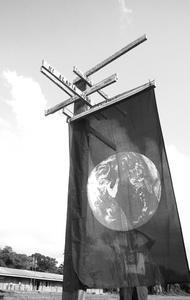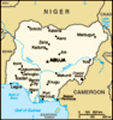Advertisement
Published: March 20th 2006

 A Pole & Peace
A Pole & Peace
Standing like a pillar of peace, the Peace Pole of the Niger Delta Friendship Library represents something larger than most can perceive.An idea, the design, research on the Peace Pole Project, a new design—and then the chainsaw; a three and a half foot blade warped in a tooth of gnawing metal. We were supposed to have the materials, and the paints, but there were none. So we improvised, Peter Titcomb and I, finding resources, scouring the bush. And with the help of three large muscular black men of the Ijaw tribe in the Niger Delta, the engine hummed, filling a quiet room of books and cataloging. Wood split, poles shaved, materials produced. The Niger Delta Friendship Library Peace Pole of Oporoza within the Creeks of Nigeria was underway.
The day was hot, bloody wet with beautiful cumuli in the sky. Their large thunderous heads rose high above an atmospheric layer, starry through a filter of Hollywood light. But this was Nigeria in the heat of the dry season.
At ground level the forest was green, lush. Tall trees stabbed at the clouds from low bush and in our field's clearing, narrow paths led into the shadows where local villagers were last seen. Peter and I hauled the newly cut panels on our shoulders, four to a stack, and sought shade

 Faces
Faces
The faces of the future who will live with the impact, whether it's peace or a continued degradation of people, lifestyle and environment.beneath the school's awning.
There, we found Prince Abekunle, cousin of the Akran of Badagry—an ancient slave port to the New World. He was inside its seedy walls performing an art class; two students in attendance. Above them, white-washed wooden panels sagged on their beams, stained a muddle of corrosive hues (would this be the fate of the pole?) Reds, browns, blacks, and a drab green melded like an amoeba in the heat, oozing with a contagious cover, making obvious the leaks in the roof.
Fortunately, to our proceeding luck—and that symbol for peace—Abekunle had extra paint; a gritty, "highly water-resistant" substance available in a few pinkish pastel colors.
I poured the amounts in plastic cups and began what first seemed to be a simple creative process, like a scribe to the Pharaoh’s speech. But this was Africa, West Africa—Nigeria to be exact.
The Peace Pole Project was a symbol of the bridge of peace between two communities; the Ijaws of Oporoza and their neighbors, the Itsekiris of the village Mandagho. Over two years ago, the Ijaws stormed Mandagho, killing their people, burning their homes. They slipped down the Creeks in a veil of night, the

 Finding Life
Finding Life
Which seems to shrink smaller and smaller as the possibilities and hopes vanish in the despoiled lands of the Niger Deltacandle-flames of gas flares flicking the horizon. Boats were quick over calm waters, warriors and their rifles—the cutlasses. Their attack was swift, the lives destroyed, but the pain was lasting, stung by the
tsetse of man's aggression.
The Itsekiris are a small tribe of Nigerians living in the oil-rich region of Delta State. Years ago, after oil began extraction and exportation in the early '60s, Chevron setup shop, installing a massive oil platform directly opposite the river from Itsekiri land. Escravos is the Statue of Liberty to the locals, and with the new economic opportunities for employment, Itsekiris created the new community center near America and called it Mandagho.
In this village of strong, smart, and progressive people who claim little land, jobs arrived on a silver platter and their society's development heightened.
America had come to Nigeria. At last, citizens strapped on oil-jumpers before light, adorned gloves and hard hat, strung identification tags, and crossed the river to Escravos. Chevron Nigeria Ltd. provided a ferry service between the divided littorals, and not only this traffic-free transport, but also funded the construction and operation of a regional hospital. Pregnant women from Mandagho and neighboring villages had the

 Gas Flare
Gas Flare
Gas Flares seem to loom around the bends in the Creeks. A strange sight, hissing and spitting 24 hours a day, they act as man's omnipresent candles within the calm dark of night.opportunity for modern-day midwifery, and children now had available the medicine to cure the common cold. Malaria, typhoid, dysentery, and other diseases, viruses, and bacteria discovered the arch nemesis of evolutionary healthcare to West Africa's wild strain. And it was Chevron who built it. It was Chevron who built it not only once—providing even more employment—but twice.
With zero there is a big 0. Empty. Nothing. When come to think of it—an unfathomable void of absoluteness. Zero is nothing; to mathematicians, scientists, wise men, and those of common sense, zero is the perfect number in every sense.
Zero is perfect. And it could be said all is zero, yet nothing at
all is zero. But such is not the case here on this planet because with one you must have two. With black there must be a white. And with Itsekiri, Ijaw are nearby.
The Ijaw people on the other hand are a large clan—a kingdom in fact. The people of the Gbaramatu Kingdom have much land, stretching far to include distant Ijaw blood. They are independent individuals, old and strong, fisher-persons at heart with large seamless dugout canoes and spear-like paddles. Nets are crafted from local
cane, trapping fish, providing meals. They live by the river. They live off the river. And unlike their neighbors, they aren't a progressive people. Instead they are slow, simple like the midday current passing toward the Atlantic. But when these currents sped near the waters where their Itsekiri brothers made home, when the tides changed for them, the Ijaws became jealous, like number One; lonely when compared to the companionship felt by number Two.
Down river, Chevron—the large multinational corporation from the promise land—was pairing with the Itsekiri people. Jobs, opportunity, a hospital, medicine, the medical care—more opportunity. The Itsekiri, as well as Chevron, struck a deep, full well in which they began to share with one another.
In Mandagho and other Itsekiri villages, cinderblock replaced bamboo and cane reed housing. Farms were built, land prepared, and educational tools taught. This was sustainable development, one with a promising future in the eyes of the Itsekiri, through the tinted bifocals of Chevron Nigeria Ltd., and from the lens NGOs and humanitarians strive to clean. At last a community of locals was being recompensated for the wealth extracted from their land, but it was only one community within a whole
region of exploitation. The Ijaws grew restless in the shadows and made their move within the cover of darkness.
In 2003, over 1,000 Ijaw and Itsekiri militia were killed. During the fighting, waterways were stalked by pirates, AK-47s, assault rifles, RPGs, and machetes patrolling the area. The air was still, but dirty as violence cut oil supply up to forty percent. Oil installations some thirty miles offshore had to be evacuated and estimated $20 million a day was lost in revenue.
All peoples of the Niger Delta suffered tremendous loss. Lives were disrupted, shattered. The oil companies' facilities were damaged, Chevron estimating repairs to cost around $600 million. More oil, gas, and blood had been shed on the earth's surface, and not solely in Nigeria, but beyond to the economies in supply of this region's high-quality crude, felt the effects. Nigeria was a bridge to the world at large.
As Peter Titcomb and I sketched, painted and assembled the Peace Pole for the Ijaws of Oporoza, the project's adage began to press its full impact:
"May Peace Prevail on Earth"—eight panels written in eight separate languages, each relating this message in its own tongue. English, Ijaw,

 Bridges
Bridges
Bridging the message of peace in Mandagho. The Peace Pole of the Itsekiris.Itsekiri, Pidgin, Yoruba, Igbo, Hausa, and Arabic. We had eight panels, painted appropriately, and one pole. Together, with the help of Ijaw villagers, the Peace Pole came alive, rose like a Frankenstein with a bunch of daisies, and stood at the front of the Niger Delta Friendship Library.
We stood back, Peter and me silent. But our smiles shone through like little children with hands of chocolate behind their backs. Peace was our sweet. We tasted it, we savored it, and we knew it was no longer ours — never was— but it was the people's, and this was the cocoa of the dessert.
Simultaneously, the two of us turned to one another and hugged. We congratulated not ourselves, but the world within us for the advancement of peace felt in every heart.
Advertisement
Tot: 0.449s; Tpl: 0.012s; cc: 34; qc: 170; dbt: 0.2247s; 1; m:domysql w:travelblog (10.17.0.13); sld: 1;
; mem: 1.7mb











Corey S
non-member comment
Beautiful
Cam, I don't have much time to write this, but I just wanted to say what beautiful pictures you submit onto your webpage. I have been saving the best shots onto my computer so I can print some off and put them on my wall. Give the photographer a pat on the back. And if the photographer is you, then keep it up man. they are really good man, the people make them beautiful. I know you're doing good over there man, keep it up. Peace man corey